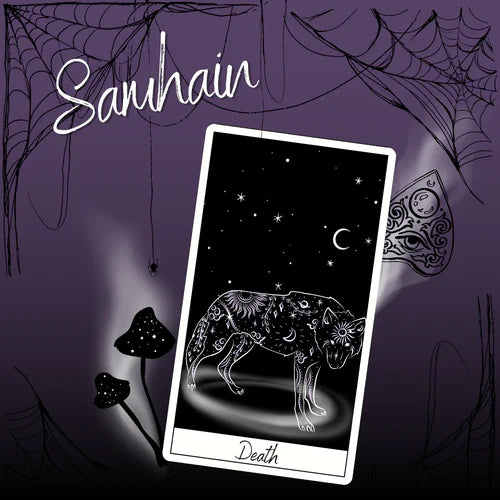Samhain, pronounced Sah-Win, is the most important Sabbath of the year as it represents the Celtic New Year. This holiday, celebrated on October 31, is the precursor to Halloween as we know it today. In the past, this festival lasted 3 days, it was mandatory and not showing up could be punishable by the Gods. Before the celebration began, all fires were extinguished and an animal sacrificed. To mark the beginning of the feast, a Druid would light a fire and throw the bones of the sacrificed animal into it, from which comes the modern English word bonfire, bone-fire.
During the night of the 31st, the Druids practiced divination since the barrier between the physical and spiritual world was breachable. Creatures of all kinds and ancestors could then cross into the physical world. Feasts were shared with the dead who came to visit and offerings were left in the fields for fairies and Sidhs. The Celts disguised themselves as monsters or animals to avoid being kidnapped by fairies. Some monsters were seen during Samhain such as Lady Gwyn, a woman dressed in white and accompanied by a black pig, Pukah, a shape-shifting creature and the Dullahan, a popular monster from the legend of Sleepy Hollow.
Samhain marked the end of summer and the beginning of winter. It was a day that belonged to no season and was not governed by the laws of the physical world. Which is why it was a time of peace, where people served feasts and drank large quantities of alcohol for 3 days and 3 nights.
In Ireland, thrones were prepared for army commanders and it was forbidden to use a weapon. During the celebration, if a crime was committed or a weapon used, it was automatically a death sentence.
In the 5th century Christianity came to Europe and the Catholic Church tried to convert the Celts. To do this, they invented All Saints Day (La Toussaint in France), celebrated on May 13th to try to incorporate Celtic holidays into the Catholic calendar and facilitate conversion (same phenomenon with Christmas, a Christian holiday, which was inspired by Yule (Celtic festival) and Saturnale (Roman festival celebrating the god Saturn) in order to facilitate assimilation). All Saints Day was moved to November 1st and All Souls Day invented and celebrated on November 2nd since the Celts refused to give up their celebration of Samhain. Over time, these holidays became All Hallows Eve and then Halloween. In the 19th century, the famine in Ireland forced Irish to immigrate to America, they brought with them their traditions such as turnip carving (now pumpkin carving) and "mumming", going door to door in costume, singing songs and receiving sweets as a reward (now called Trick or Treating).
Our modern Halloween celebration is not much different from what the Celts did hundreds of years ago.
How to celebrate:
- Throw a costume party
- Share a feast with friends and drink alcoholic or non-alcoholic beverages
- Carve pumpkins
- Play tricks on our friends, and blame the fairies like the Celts did
- Have a little celebration for your deceased loved ones, write them a letter, say a little prayer, talk about them and good memories you have with them or leave an offering for them on your altar
Of course, we invite you to be inspired and to create your own activities!
- Tan
Source: https://www.worldhistory.org/Samhain/ And https://www.history.com/topics/holidays/samhain .
